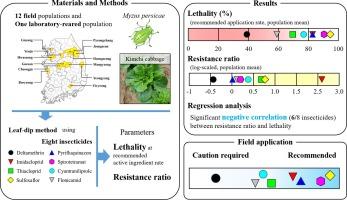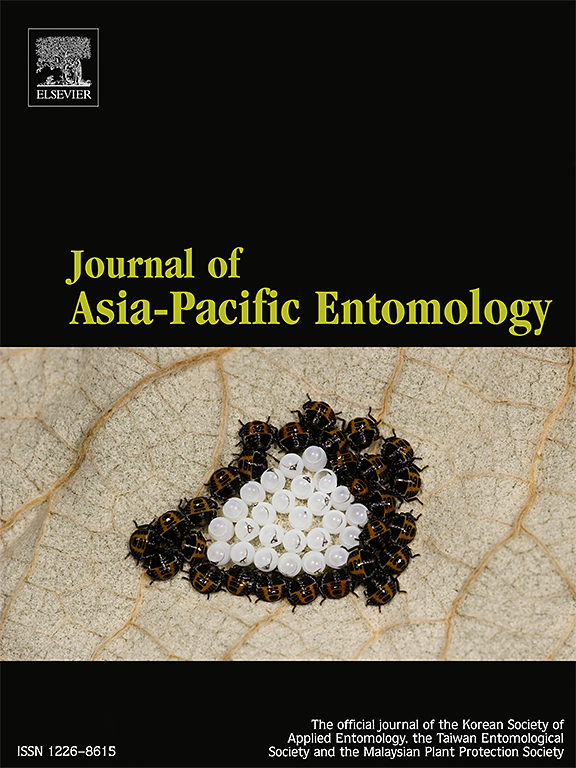Control efficacy of eight insecticides on Myzus persicae (Hemiptera: Aphididae) and insecticide resistance development of aphid populations collected from kimchi cabbage in South Korea
IF 1.1
3区 农林科学
Q3 ENTOMOLOGY
引用次数: 0
Abstract
Insecticide control efficacy was investigated with Myzus persicae (Hemiptera: Aphididae) populations collected on kimchi cabbage across South Korea, and their insecticide resistance levels were evaluated. Using a standard leaf-dip bioassay, the lethality at recommended active ingredient rate and lethal concentration 50 (LC50) were acquired. Then, the resistance ratio was calculated as ratio between LC50 of field population and LC50 of laboratory population. Finally, regression analysis was conducted between the log-scaled resistance ratio and the lethality to address associations between the two estimators. Overall, sulfoxaflor and spirotetramat were the most effective insecticides, where > 80 % lethality was observed from almost all local populations. Nevertheless, five out of 12 local populations showed the resistance ratio > 5 to sulfoxaflor, suggesting resistance development to the insecticide. Imidacloprid and pyrifluquinazon also offered effective means to control M. persicae. However, large variations in the lethality, as well as the resistance ratio, were observed in imidacloprid. Deltamethrin was the least effective at recommended active ingredient rate yielding 20.2 to 63.2 % lethality, despite its low resistance ratio values. Finally, regression analysis revealed that there was in general significant negative correlation between the resistance level and the insecticide control efficacy in the insecticides evaluated. Moreover, the insecticide control efficacy declined with substantially varying rates among the insecticides with flonicamid, thiacloprid, and deltamethrin showing steeper slopes. These results indicate that both the current control efficacy and its projected decline regarding the resistance development should be taken into account together to formulate effective and sustainable management programs against M. persicae.

八种杀虫剂对韩国泡菜蚜虫(半翅目:蚜科)的防治效果以及从泡菜中采集的蚜虫种群的杀虫剂抗药性发展情况
对韩国各地收集的泡菜上的柿蚜虫(半翅目:蚜科)种群进行了杀虫剂防治效果调查,并对其杀虫剂抗性水平进行了评估。采用标准的浸叶生物测定法,获得了推荐有效成分用量下的致死率和致死浓度 50(LC50)。然后,根据田间种群 LC50 与实验室种群 LC50 之比计算抗药性比率。最后,在对数标度的抗性比率和致死率之间进行回归分析,以解决两个估计值之间的关联问题。总体而言,磺胺草酮和螺虫酯是最有效的杀虫剂,几乎所有当地种群都观察到了 80% 的致死率。不过,在 12 个本地种群中,有 5 个种群对磺胺草醚的抗药性比率为 >5,表明对该杀虫剂产生了抗药性。吡虫啉和吡氟喹禾灵也提供了有效的杀虫手段。不过,吡虫啉的致死率和抗药性比率差异很大。在推荐的有效成分用量下,溴氰菊酯的效果最差,致死率从 20.2%到 63.2%不等,尽管其抗性比值较低。最后,回归分析表明,在所评价的杀虫剂中,抗药性水平与杀虫控制效果之间普遍存在显著的负相关关系。此外,不同杀虫剂的杀虫效果下降率也大不相同,其中氟啶虫脒、噻虫啉和溴氰菊酯的下降斜率较大。这些结果表明,在制定有效和可持续的虫害防治方案时,应同时考虑当前的防治效果及其因抗药性发展而预计出现的下降。
本文章由计算机程序翻译,如有差异,请以英文原文为准。
求助全文
约1分钟内获得全文
求助全文
来源期刊

Journal of Asia-pacific Entomology
Agricultural and Biological Sciences-Insect Science
CiteScore
2.70
自引率
6.70%
发文量
152
审稿时长
69 days
期刊介绍:
The journal publishes original research papers, review articles and short communications in the basic and applied area concerning insects, mites or other arthropods and nematodes of economic importance in agriculture, forestry, industry, human and animal health, and natural resource and environment management, and is the official journal of the Korean Society of Applied Entomology and the Taiwan Entomological Society.
 求助内容:
求助内容: 应助结果提醒方式:
应助结果提醒方式:


